Huss & Dalton of Staunton, Virginia have made fine acoustic guitars since 1995, combining traditional and contemporary aspects of design to offer a look, feel and sound subtlety unique and notably appealing. A fine example of their work may be found in their TD-M, a Traditional Dreadnought made from Mahogany. But this TD-M Custom model definitely kicks things up a notch.
Features include: Dreadnought body size, solid sinker Mahogany back and sides, solid Appalachian red spruce top, forward-shifted scalloped braces, figured mahogany neck with a gentle vintage V, faux tortoise body binding, ebony fingerboard with ebony binding, 1-23/32″ neck width at nut, ebony belly bridge with a long bone saddle and ebony pins, 2-7/32″ string spacing, Waverly nickel open back tuners
~
(watch on YouTube in Hi-Def for best sound quality)
TD-M Custom
Full Review
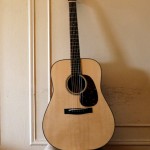
Here is a good example of a Bluegrass banjo killer with focused trebles that cut through the stout, strong bass of its pronounced bottom end. It is exceptionally full-bodied for a mahogany guitar.
Huss & Dalton attach the term “Custom” to an instrument built with any variation from their normal catalog specs, in much the same way other manufacturers might designate something as a Special. This guitar had the normal Sitka spruce top upgraded to Adirondack spruce, here more accurately called Appalachian red spruce. That was enough to earn the custom designation. But what makes this guitar truly special is the sinker wood used for the back and sides.
Wonderful Wood
The body is made from a log of old growth mahogany that lay at the bottom of a river in Belize since the late 1800s. Wisely, the usual dark stain was avoided in an effort to better display the dramatic quartersawn figuring on the back, possibly caused by mineral absorption during its submersion.
Shimmery golden streaks peer out from broad tongues of brick red and burnt umber that surge up from the bottom end, over fields of new-penny copper, with glinting flecks of amber and gold thread all over the place, giving the back an almost koa-like appearance.
When viewed as a whole, it reminds me of staring into a rousing bonfire, and it is just about as hypnotic to look at.
 |
 |
 |
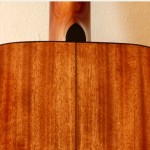 |
The solid mahogany neck has a twisted grain pattern that ultimately lines up just where it meets the grain of the sides, which are perfectly quartersawn with uniform banding. As a result, the neck looks almost like a tree limb growing right out of the body.
The red spruce top has consistent spacing of healthy width, narrowing directly under the strings. There is omnipresent cross-silking and a pattern of faint mineral stripes, nicely bookmatched on either side of the center seam. A dome effect from the 25-foot top radius is noticeable, but only when you tilt the guitar to look at it from the edge.
Welcome details include the attractive faux tortoise shell used for the pickguard and body binding, and the ebony binding on the ebony fingerboard, so there are no exposed fret ends. The fretboard markers are dots of decreasing size, in the tradition of Martin’s Style 18, and made of pure argent mother-of-pearl with blue holographs.
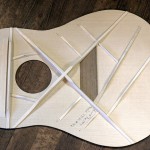
The Huss & Dalton belly bridge is also carved from high quality ebony, and it has a distinctive shape with softer, graceful lines, making it a bit narrower and less boxy than that of other brands. Bone is used for the nut and saddle, the latter being a long “through saddle” which helps transfer string vibration across a wider portion of the bridge plate. Each string was compensated individually, and the bridge plate is made from Honduran rosewood, which should stand up to the gnawing of metal string balls better than the usual maple bridge plates.
Hand-split red spruce is used for the bracing. As with much of the H&D craftsmanship and aesthetic, they appear both classic and innovative. The top braces are forward-shifted and scalloped, with an X brace that is sliced quite narrow where it meets the spruce top, until near the center junction, where the surface flattens out, with notably greater surface area to support the upper bout. They also sport the exclusive parabolic tapering used to create the top radius. But unlike most models in their catalog, the Traditional range does not use radiused sides, which gives the guitar a more customary look and sound.
Holy Smoky Mountains!
In a word, the voice is huge. The recording gear was set up and calibrated using a Martin D-18 with forward-shifted braces, before the owner brought this guitar for review. The TD-M Custom blew the meters right off the scale. This baby moves a lot of air and fills it up big time.
Besides the impressive volume, it has a prominent low E string with a fat throb. But the guitar is voiced so that the A string provides the dominate harmonics, triggering added overtones from the B string. This has two key results. First, it keeps that big ol’ E string fundamental from throwing the overall voice out of balance. The E string has a louder top note; the A string sparks a plumper harmonic. Together they make for a warm sing-song alternate-bass effect.
Secondly, the A string sympathetics saturate the undertone and extend the bottom frequencies, at times reaching underneath the lowest fundamental treble notes. This adds some richness to the high end, and provides a warmth to the entire voice beyond what one normally hears in mahogany dreadnoughts – particularly when topped with red spruce.
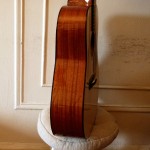
As top woods go, red spruce brings a high chime factor and great definition. Otherwise it is basically transparent, offering the least amount of filtering colors to the tonal palette, which puts the focus on the sonic qualities of the wood used for the body. It is also highly reflective, with a dry, snappy “ping” and quick sonic pulses. What is reflected in this case is some seriously dense tonewood. The throaty warmth in this hog of a dread might have gotten a little too warm and woofy if it had been topped with Sitka or European spruce.
While it still sounds like mahogany – clear and bright compared to a darker, thicker rosewood guitar – it is full-bodied, with a great deal of bottom end oomph. The exceptionally dense properties of the tonewood are apparent in the extra presence under the low mids and the sheer volume emitted by even the most relaxed playing.
While the density of this mahogany may be due in part to the fact it is old growth, or the particulars of the microclimate where it grew, the prime suspect is its submersion in a jungle river. It likely became inundated and sank during a logging run, and then soaked up a century’s worth of silt containing organic matter, salts and minerals, leading to what might be considered the preparatory phase of petrification.
In simpler terms, it’s really hard. But it is not hard to play.
Playability
It feels sleek to the fretting hand, with the vestige of a vintage-style V running along the apex of the neck. While it has the same 16″ fretboard radius of a Martin, the extra 1/32″ in the nut width keeps the neck from feeling “skinny.” At the other end, the string spacing is 1/32″ shy of 2-1/4″, almost OM width, so the picking hand never feels cramped. The V is not as pointy as a comparable Martin, but it is not so modernized that traditionalists would find it too shallow.
The owner of this guitar keeps the action pretty high, and hammer-ons require some piston fingering in the upper frets. But it is within traditional specs, and the finely tuned saddle compensation allows for Bluegrass action without disturbing the general intonation.
I have moved away from vintage style necks as my old high school football injury gets worse with age. On the whole, this neck is pretty easy to play. Barre chords are not an issue, and in fact they have clear definition across the notes. But thumb-fretting higher up was no fun at all. This is not due to width so much as the carving of the cheeky V. Still, it is a lot better on my hand than anything like the bulk found on a prewar guitar.
Tonality
The unwound strings have a flashy metallic chime while the wound strings stand up and out, with strong, straight-as-an-arrow sustain. There is minimal waver in the ring of the top notes and a discernible separation between them and the humming undertone, which sounds like a certain “openness”, particularly under the high-mids and treble. All typical of acoustic guitars made with bolt-on necks.
As such, this guitar is reminiscent of dreadnoughts built by Dana Bourgeois and to a lesser extent Bill Collings. This Huss & Dalton stands apart in the feel of the neck and spacing, and when it comes to the sonic details, particularly in the relationship between those fundamental notes popping off the strings and the undertone and high harmonic overtones glowing out around them.
There is a crisp snap and ring as the strings are played. But each fundamental seems to increase in volume immediately after the initial report, which makes them “bloom” into what becomes the level, sustaining note. It is really quite lovely in its effect.
The bass is full and round, but the treble is open. The undertone of the lows is thick and the space between the sympathetics and the top notes is shallower, as they swell up to hug the fundamentals. But the undertone in the mids and highs stay farther down, with only the primary unison harmonics rising up when triggered on a lower string. This creates a scooped out “special effect” in the high end. I love how the undertone has a gradated presence that decreases as it nears the unwound strings, and then suddenly drops out, leaving a clear open window beneath the topmost treble notes.
The mids set back as a result, especially for a Huss & Dalton. But the midrange fundamentals still have a good deal of pop when whacked with a flatpick. This guitar has old timey flatpicking written all over it, yet it actually works very well for fingerstyle. When played with restraint, the chimey top notes balance out and the undertone stays in the background. When one digs in like I do, that bass swells up, even if it is countered some by an increase in the highest highs. Singer-songwriter types would likely welcome this addition of a personal bass player without actually having to hire one.
Conclusion
The voice of this TD-M Custom Sinker Mahogany guitar lives in a big room with high ceilings and wide open windows, letting in lots of sunlight, while leaving some darkness in the farthest, shadowy corners. One must experience such an instrument in person to fully understand what I mean by that.
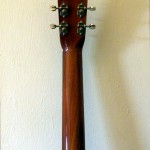
If you are familiar with the brand, I can say this guitar is warmer, fatter and more resonant than even some rosewood Huss & Dalton offerings, as that dense tonewood and reflective spruce reverberate and amplify each note and every strum. It still sounds like mahogany, but mahogany that has been working out in the weight room.
What I liked most about it was the sheer volume and power, with a righteous Appalachian ring thing going on.
What I liked least was the neck and string spacing. V necks are becoming problematic for my hand, especially when it comes to thumb-fretting up the neck. And the spacing on this guitar is just different than any guitar I own, so it took a while to stop landing in the wrong places. But others, like Goldilocks, may find it to be just right.
The bottom line: I have played sinker mahogany guitars by other makers. All have been exceptional and this one stands out as well. It is a beauty easy on the eyes and ears: voluptuous in all the right places, but clear and uncomplicated just when you want it to be.
And that is one man’s word on…
Huss & Dalton TD-M Sinker Mahogany
Special thanks to Kimberly Dalton for the great bracing photography!
We’d love to hear your thoughts on this review, or any Huss & Dalton guitar YOU have played.
~
Here’s supplementary video showing the owner demonstrating the sort of music he plays on his guitar.
(play on YouTube in Hi-Def for best sound quality)
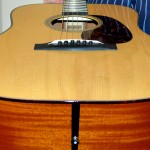
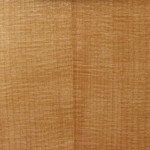
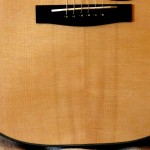
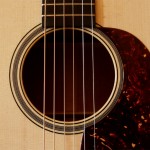
You, sir, are a wordsmith of the highest order.
I fancy myself a creative writer and always appreciate a kindred spirit in that regard, but this is the best write-up relating to an instrument I have ever seen. I could actually feel the joy on my face when I read the first sentence under ‘Conclusion’. Suffice it to say that this is not a clunky technical piece like you might find in Guitar Player, or the like, but rather feels like I stumbled upon Charles Dickens with a BlueChip in hand. Bravo.
By the way, I just purchased a 2011 TD-M Custom sinker mahogany (which is how I found your site) and haven’t even received it yet, but this review has me salivating. I will report back.
Congratulations. I do hope you find the time to report back regarding your new-to-you TD-M Custom!
And thank you for very kind words!
Fantastic Review,
I really enjoyed the description of the individual string balance, the overall sound is striking, yet, warm enough. Interesting fact about the actual string spacing. I own a Collings Triple 000 HD, and, find the different string spacing (1 13/16 ” and saddle at 2 5/16 “) an adjustment, particularly when I’ve played one of my other guitars with a 1 3/4” nut. I am quite smitten with that Mahogany sound, a change from the Rosewood hand made guitars I own. Thanks for a very thorough review. Coincidentently, I have been watching many reviews this past week, involving Huss, along with Molly Tuttle displaying various Huss & Dalton dreadnoughts.
Ron Driedger
How does the neck attach to the body?
Huss & Dalton use a modern bolt-on neck. I have never seen the neck joint, so I do not know if it has a dovetail shape to the slot, like Collings, or if it is a narrow slot like most other bolt-on necks.
Thank you George, and Stephen. Yes, that is one man who was lucky enough to score some serious sinker mahogany on a serious Huss & Dalton dreadnought!
Review, guitar, and playing were all exceptional.
You have quite a “tonal palette” of language and words, sir. the guitar sounds rich and deep, shimmering. Beautiful guitar and review.